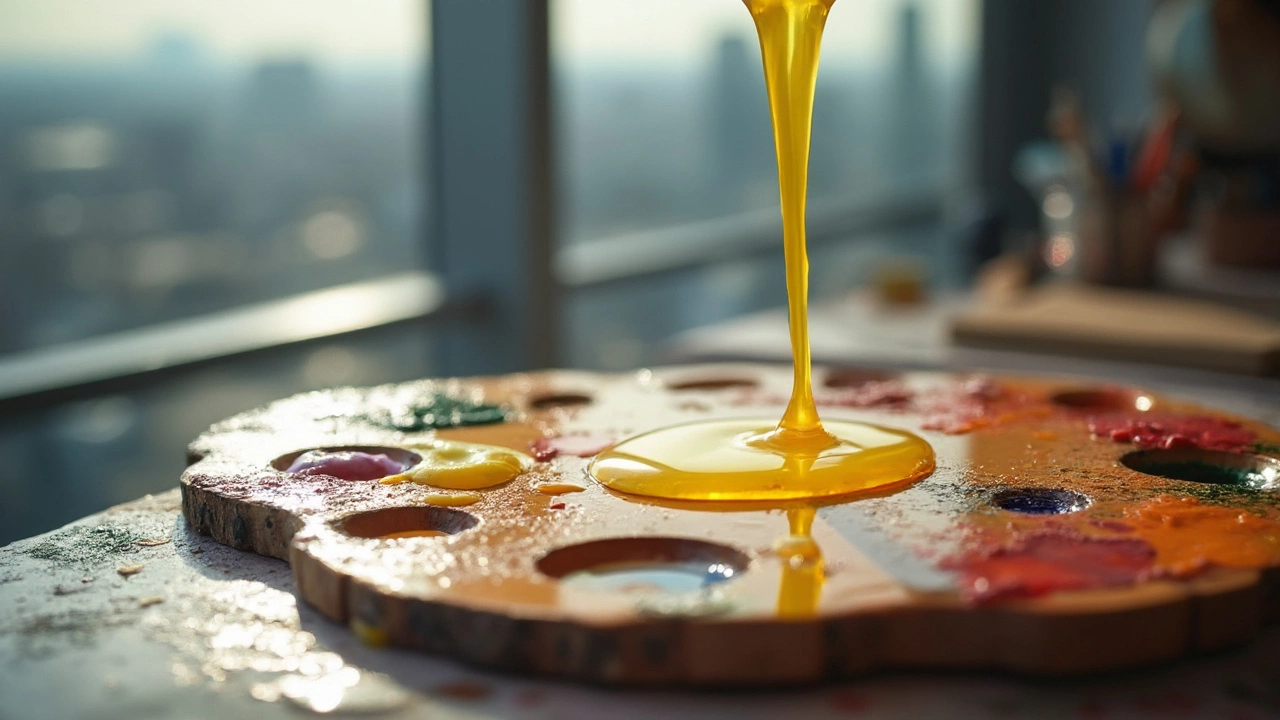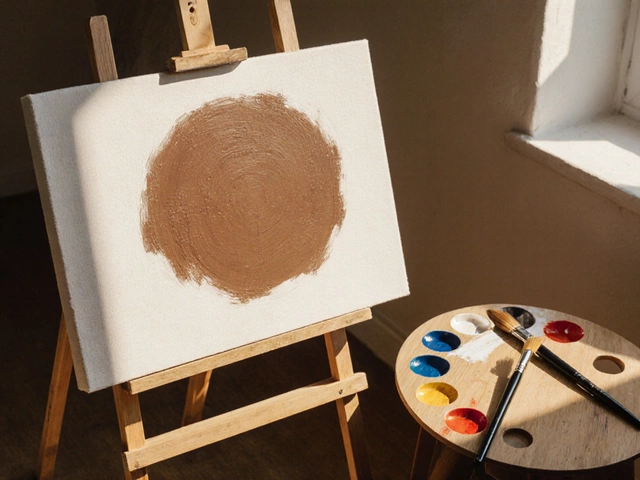If you're getting started with oil painting, you've probably heard about linseed oil. But do you really need it? Let's break it down. Linseed oil is a natural oil extracted from flax seeds, and it's one of the most common mediums used by painters. Now, why is it so popular in oil painting?
For starters, it has this magical ability to enhance the gloss and transparency of colors. Imagine those vivid colors popping on your canvas—linseed oil can be a big helper. It also slows the drying time of your paint, giving you more flexibility to work and blend colors. So if you're someone who likes to take their time crafting a masterpiece, this might be a game-changer.
But here's something interesting—not all artists use it. Some prefer other mediums, and some want no additives at all. It really comes down to the effects you're looking to achieve. Let’s explore whether you should give linseed oil a try or perhaps consider alternatives.
- Understanding Linseed Oil
- Why Artists Use Linseed Oil
- The Impact on Color and Texture
- Alternatives to Linseed Oil
- Tips for Using Linseed Oil
Understanding Linseed Oil
Let's talk about linseed oil. It's a staple in the art world, especially when we're diving into oil painting. So what exactly is it? Linseed oil is pressed from the seeds of the flax plant. It's nothing new—artists have been using it for centuries, way before we had all these fancy modern mediums.
This oil is highly favored for a couple of reasons. First, it’s a fantastic binder, which means it helps pigments stick together and spread smoothly on canvas. That’s why many painters use it, but there's more to it.
The Different Types
Surprise! Not all linseed oils are the same. You've got refined linseed oil, which is your all-rounder. It's clean and versatile. Then there's cold-pressed linseed oil; artists love it for its purer form since it's straight from the seeds without refinement. On top of that, we have stand oil – it's thicker and improves the flow and leveling of the paint.
How It Affects Your Painting
Using linseed oil means more than just mixing a liquid into your paint. It can actually change the texture and even the longevity of your work. A little bit of oil makes the paint more fluid and easier to work with. But watch out—too much can lead to a glossy, almost greasy finish. Balance is key!
If you're someone who loves details, linseed oil lets you work with layers (ever heard of 'fat over lean'?). The slow drying time means you can rework areas and build up textures in a way that’s hard to do with faster-drying mediums.
Interesting Fact
| Type of Linseed Oil | Drying Time |
|---|---|
| Refined Linseed Oil | 2-4 days |
| Cold-Pressed Linseed Oil | 3-5 days |
| Stand Oil | 7-10 days (least likely to yellow) |
This table shows you how different types of linseed oil influence drying times. The choice of oil can affect not only your work pace but also the final look of your piece. So next time you're in an art store or browsing online, knowing your linseed oil can make a world of difference!
Why Artists Use Linseed Oil
So, what's the big deal with linseed oil? There are several reasons why artists consider it a staple in their studio. One of the primary reasons is its amazing effect on the paint’s consistency. When added to oil paint, it makes the paint smoother and flow more easily, which can be particularly useful when you’re trying to achieve a specific stroke or detail.
Another perk of using linseed oil is how it boosts color vibrancy. Have you ever noticed how some paintings seem to glow? This oil can add a depth and richness to pigments, making them stand out. Artists often use it to maintain the luminosity of their colors over time, keeping their artwork looking fresh and vibrant.
More Control Over Drying Times
One feature many artists appreciate is the control over drying times. Linseed oil extends the drying time of paints, allowing for more flexibility. This can be a lifesaver if you like to make changes or need more time for blending. The extended working time means you can refine details without rushing.
Durability and Finish
Not only does linseed oil affect color, but it also enhances durability. Paintings with linseed oil tend to withstand the test of time. The oil acts as a protective barrier, reducing the risk of your artwork cracking or losing its luster. Plus, it gives the painting a nice gloss finish, which many artists find visually appealing.
Ultimately, linseed oil can be an artist's best friend in creating beautiful, long-lasting, and high-quality artwork. But, like any tool, it's essential to understand how to use it to serve your artistic goals best.

The Impact on Color and Texture
Using linseed oil in your oil painting can change the game when it comes to color and texture. Let’s talk about how it works. First off, linseed oil gives your colors a rich, glossy finish. This is particularly useful if you're aiming for vibrant, luminous artwork. The oil allows light to pass through the paint layers, enhancing the depth and saturation of your colors.
Texture-wise, linseed oil can smooth out your paint, making it more spreadable. If you're into blending, this feature is gold. It helps you create seamless transitions between colors, which is ideal for complex gradations or soft portraits. Plus, the paint layer stays wet longer, which means more time to fine-tune the details.
Layering and Glazing
Glazing is another area where linseed oil shines. By mixing a small amount of linseed oil with paint, you create thin, translucent layers that can be stacked. This technique can add depth and subtle color variations, which can be stunning in landscape paintings or detailed abstracts.
Adjusting Drying Time
One major impact of linseed oil is on drying time. The oil slows down the drying process, which can be a blessing or a burden, depending on your style. If you like tweaking and perfecting, you'll appreciate the extended workability. But remember, the more linseed oil you add, the slower it dries.
Ultimately, your choice to use linseed oil should be guided by the effects you want. If you crave bold colors and smooth textures, it's worth experimenting with. On the flip side, if you're after different effects, you might explore other mediums. Understanding how linseed oil impacts your paints and how it meshes with your style is key to making the most of this versatile art supply.
Alternatives to Linseed Oil
So, you've decided linseed oil might not be for you. What's next? Well, you're in luck because there are several alternatives out there that could suit your needs just as well, if not better. Here's a quick rundown of some popular options.
Walnut Oil
Let's talk about walnut oil. This one is super popular among artists looking for a nontoxic option. It’s known for drying faster than linseed oil, which can be handy if you don’t want to wait too long between layers. Plus, walnut oil has a tendency to yellow less over time, making it a great choice if you're concerned about long-term color integrity.
Poppy Oil
Then there's poppy oil, which is famous for its slow drying qualities. This can be a boon if you like to blend your colors for longer periods. It's also less prone to yellowing, much like walnut oil. However, be mindful that it’s best used for lighter colors due to its slow drying time and potential for cracking.
Stand Oil
If you're aiming for a super-glossy finish, consider stand oil, which is a thickened version of linseed oil. It may not dry super quick, but it levels out brush strokes beautifully. Just remember, because it's so viscous, it's usually mixed with a thinner medium.
Alkyd Mediums
For those who want modern solutions, alkyd resins are the way to go. These speed up drying times significantly and can add a nice gloss to your paint. Younger artists often find them appealing for quicker project turnover.
| Oil Type | Drying Time | Prone to Yellowing |
|---|---|---|
| Walnut Oil | Medium | No |
| Poppy Oil | Slow | No |
| Stand Oil | Slow | Yes |
| Alkyd Medium | Fast | No |
Clearly, you've got options! Figuring out which medium works best might take some experimentation, so grab a few and see how they impact your style and workflow. The best part? You can always mix and match to find your perfect combination!

Tips for Using Linseed Oil
Let's chat about making the most of linseed oil in your art. First up, knowing how much to use can make a big difference. Too much linseed oil and you might end up with a sticky mess. The key is moderation.
Start Simple
If you're new to this, start with a simple mix. Typically, a ratio of one part linseed oil to three parts paint can work. Of course, tweak it based on how thick or thin you like your paint.
Layering Techniques
Using the 'fat over lean' technique is a smart move. It means each new layer should have more oil than the last. Why? Because it prevents cracking as the painting dries. Try starting with a lean layer: that means less oil in your base layers and more as you progress.
Pre-Test Colors
Before diving into your main piece, do a quick test on a scrap. This lets you see how the color dries and if it achieves the gloss or transparency you want.
Protect and Preserve
Once your masterpiece is finished, consider adding a final layer of varnish. This not only protects your painting but enhances the glossy effect of the oil.
Common Mistakes
- Avoid using linseed oil as a cleaner or thinner. There's a difference! Keep some turpentine or mineral spirits handy for those tasks.
- Be mindful of dust and particles. Because oil slows drying, your painting is pretty exposed for a while. Maybe cover it with a clean box or cloth, but ensure it's not touching the surface.
Remember, experimenting is part of the fun. Play around with different mixes and techniques until you find what works best for you and your style. Happy painting!



